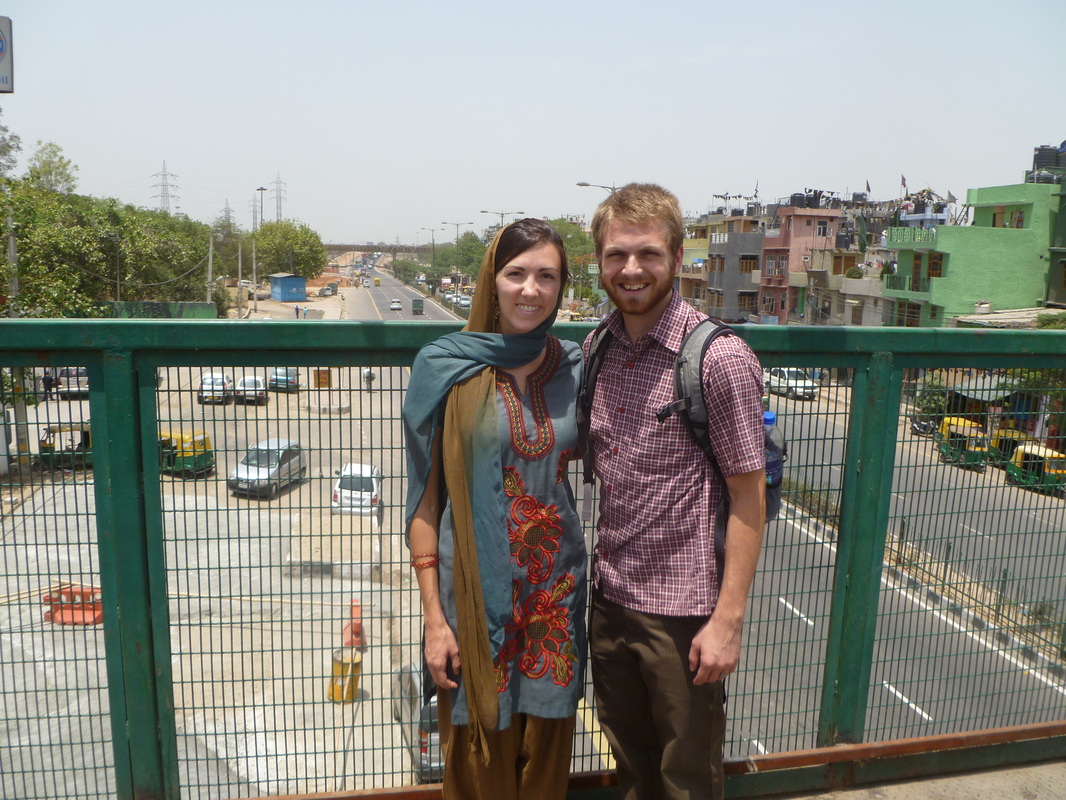After three weeks, we feel like we’re really settling into our new home. Of course, that initial victory hasn’t been won without some battle scars—namely, the swollen casualties suffered because of a hole-y mosquito net and an underestimation of how ferocious these little creatures can be!
We’ve settled into a daily routine of waking up around 7, taking some quiet moments to prepare for the day, to talk with our Father, to take a “bucket shower” and start the day with the refreshment of a cold bath. We join the family around 9 for a breakfast of chai, chapattis, and vegetable curry or whatever is left over from dinner the night before. The morning is spent doing laundry and helping to prepare food and do chores around the house, and we’ve enjoyed re-learning all of those basic activities like small children. “In America, you don’t clean the house?” our host sister asked the other day, confused by our apparent inexperience. We try to explain that we do, but the process is so different that it hardly seems like the same thing! Throughout the day, we practice Hindi, learn new words, study the things we’ve written in our notebooks, and struggle to spell things in the Hindi script. When we show our attempts to our hosts, they often laugh and rewrite completely different words than we thought we heard. We’re still learning how to hear the strange sounds of our new tongue. Five times a day, the call to prayer rises from a loudspeaker. Five or six times a day, we drink chai with the family. In the afternoon, when it is hottest outside, most people take a nap, and usually, so do we. In the evenings—now that we have a bit of basic language—we sometimes go out to talk with neighbors, and sometimes are invited over to their homes for more chai. Dinner happens anytime between 8:30 and 10 o’clock at night, and after that we usually sit around talking with our host sisters and our host brother, who gets home from work just before dinner. Throughout the day, we hang out on the front step to talk with people walking past, or to laugh at the water buffalo that lives in front of the house across the street. Occasionally, we make a trip to the market with our host father to buy vegetables, or to the huge community milk vending machine called “Mother Dairy”. At night, we head back to our room around 10 or 10:30, spend the next half hour mosquito-proofing ourselves for the night and go to sleep. We’ve really enjoyed becoming part of the family’s daily rhythms of work and relaxation, and learning more from them each day. It’s such a blessing to have a safe environment within their home to make our first cultural blunders, and we’re so thankful to have advocates and friends who can help to integrate us into the community.
Up to this point, A. and I have been doing most of our long-distance travel on the modern, air-conditioned metro system, but most of our neighbors are limited to the un-air conditioned and less reliable bus system because it’s cheaper. So last Wednesday we decided to take the bus to our friends’ place on the other side of the city. We piled into a crowded little van (but van is a strong word… it implies full enclosure) for the first unpaved leg of the journey, out of our community to the highway. Then we waited for nearly half an hour at the bus stop. While we waited, a very crowded bus came by and a few people scrambled on, some still hanging outside the door and trying to force their way inside as the bus sped away. Finally, ours showed up and we piled on. It was crowded and hot, but we were excited to be above ground and able to see all of the street-level activity between point A and point B. A few minutes down the road, a rhythmic, jolting, thudding starts under the floor of the bus. We look behind us to where the last passenger aboard is standing in the doorway, clinging to the outside of the bus. He is looking down at the tire, and seems somewhat amused. The motorcycle and truck drivers passing us are all staring in that direction, too—apparently the tread is coming off the tire and flinging against the bottom of the bus with each rotation. At the same time, we’re beginning to notice the grinding of the gears and the halting acceleration after each stop of the bus. We aren’t sure which problem will take down the bus first. As we’re sitting in a traffic jam at a huge, unregulated intersection with a cross flow of rickshaws, motorcycles, trucks, cars, and buses in front of us, we stare into the rooftops and inner rooms of the slum dwellings that line the highway, divided only by a canal of open sewage and huge pipes serving as walkways over the water. A man repairs a power line standing on a bamboo ladder whose bottom rung is just a couple of feet away from our back tire. Pedestrians and bicycles hurry past between the tire and the ladder. A few minutes later, the transmission beats the tire to its demise and everyone moves from our bus to another one further ahead in the traffic jam. This one runs on a slightly different route, but we manage to get off at approximately our desired destination and take another “van” to our friends’ community. After all of that, we still manage to reach their front door in less than two hours!
Yes, life here is good.


